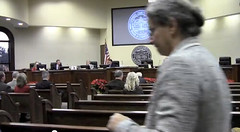Knoxville News editorial of 14 March 2010, Chalk two up for open government
So eventually CCA will have to surrender at least some of the records, although there is still haggling in court over which exceptions CCA can use for which records. (And there’s always the old “we didn’t keep them that long” trick.)CAA[sic] maintained it wasn’t the functional equivalent of a government agency, but the Appeals Court rejected that claim and the Supreme Court refused even to hear it.
“With all due respect to CAA[sic],” Appeals Court Judge D. Michael Swiney wrote in his opinion on Friedman’s case, “this Court is at a loss as to how operating a state prison could be considered anything less than a governmental function.”
The Tennessee Supreme Court had already ruled about government contractors:
“When a private entity’s relationship with the government is so extensive that the entity serves as the functional equivalent of a governmental agency, the accountability created by public oversight should be preserved.”I wonder if Georgia will accept a Tennessee precedent?
-jsq











